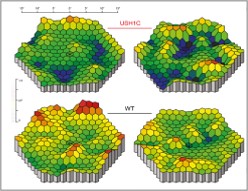New pig model for Usher syndrome type 1
07.04.2022
Usher syndrome (USH) is the most common form of monogenic deaf-blindness. Loss of vision is untreatable and there are no suitable animal models for testing therapeutic strategies of the ocular constituent of USH, so far. By introducing a human mutation into the harmonin-encoding USH1C gene in pigs, a team led by Nikolai Klymiuk generated the first translational animal model for USH type 1 with characteristic hearing defect, vestibular dysfunction, and visual impairment. Changes in photoreceptor architecture, quantitative motion analysis, and electroretinography were characteristics of the reduced retinal virtue in USH1C pigs. Fibroblasts from USH1C pigs or USH1C patients showed significantly elongated primary cilia, confirming USH as a true and general ciliopathy. Primary cells also proved their capacity for assessing the therapeutic potential of CRISPR/Cas-mediated gene repair or gene therapy in vitro. AAV-based delivery of harmonin into the eye of USH1C pigs indicated therapeutic efficacy in vivo.


